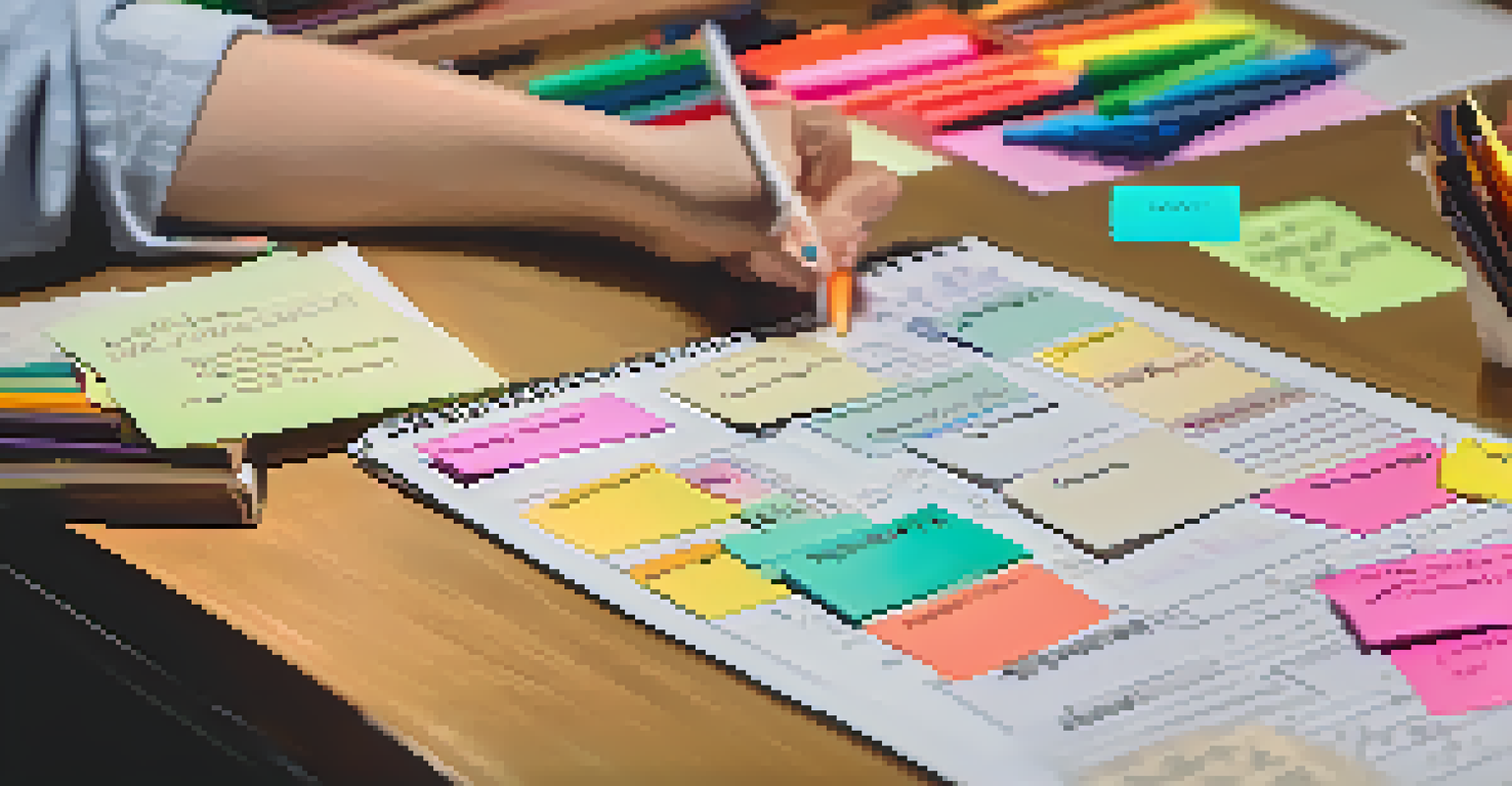Flipped Classroom: Designing Assessments for Learning

Understanding the Flipped Classroom Concept
The flipped classroom is a teaching model that reverses traditional learning. Instead of introducing new content in class, students engage with it at home through videos or readings. This approach allows classroom time to be used for interactive activities and personalized support.
Assessment is the bridge between teaching and learning.
In this model, students prepare before coming to class, making the learning experience more dynamic. Teachers can then focus on facilitating discussions, answering questions, and guiding students through problem-solving. This shift not only enhances student engagement but also fosters a deeper understanding of the material.
Ultimately, the flipped classroom empowers students to take charge of their learning. They can learn at their own pace and revisit challenging concepts outside of class. This setup naturally leads to more thoughtful assessment design that aligns with the learning objectives.
The Importance of Assessment in Learning
Assessment serves as a vital tool in education, helping to gauge student understanding and progress. In a flipped classroom, assessments must be designed to support the learning process rather than merely evaluate it. By focusing on formative assessments, teachers can provide ongoing feedback that guides students towards mastery.

Effective assessments encourage students to reflect on their learning and identify areas for improvement. This is especially important in a flipped model, where students may engage with the material independently. By incorporating self-assessments and peer assessments, teachers can foster a collaborative learning environment that promotes growth.
Flipped Classroom Enhances Engagement
The flipped classroom model allows students to learn at their own pace at home, making classroom time more interactive and focused on personalized support.
Additionally, assessments should align with the learning objectives set for the course. In a flipped classroom, this means creating assessments that encourage analytical thinking and application of knowledge. When students can see the relevance of their assessments, they are more motivated to engage meaningfully with the material.
Designing Assessments for Flipped Learning
Designing assessments for a flipped classroom requires a shift in mindset from traditional exams to more interactive evaluations. One effective approach is to use project-based assessments that allow students to demonstrate their understanding through real-world applications. This not only assesses their knowledge but also develops critical thinking and problem-solving skills.
The best feedback is that which allows the learner to understand the process and make adjustments to their learning.
Another strategy is to incorporate technology into assessments. Online quizzes, discussion boards, and multimedia presentations can foster creativity and collaboration among students. By utilizing these tools, educators can create a more engaging assessment experience that reflects the flipped classroom philosophy.
It's also essential to consider the timing of assessments. Regular, low-stakes assessments can provide students with opportunities to practice and receive feedback throughout the learning process. This helps to create a safe space for students to explore their understanding without the pressure of high-stakes testing.
Types of Assessments in a Flipped Classroom
In a flipped classroom, various types of assessments can be employed to cater to different learning styles. Formative assessments, such as quizzes and polls, can be used during class to gauge student understanding in real-time. This immediate feedback helps both students and teachers adjust their approaches as needed.
Summative assessments, on the other hand, can take the form of projects, presentations, or exams at the end of a unit. These assessments should be designed to reflect the skills and knowledge students have gained through their flipped learning experiences. By emphasizing application over memorization, summative assessments can provide a clearer picture of student learning.
Dynamic Assessments Foster Growth
In a flipped classroom, assessments should prioritize formative feedback and real-world applications to effectively gauge and enhance student understanding.
Additionally, authentic assessments that mimic real-world tasks can be particularly effective. These assessments encourage students to apply their knowledge in practical situations, fostering deeper learning and retention. When students see the relevance of their assessments, they are more likely to invest effort into their learning.
Incorporating Feedback into Assessment Design
Feedback is a crucial element in the assessment process, especially in a flipped classroom. It should be timely, specific, and constructive to help students understand their strengths and areas for improvement. Regular feedback loops encourage students to reflect on their learning and make necessary adjustments.
Incorporating peer feedback can also enhance the learning experience. Students can learn from one another's perspectives and insights, fostering a collaborative classroom environment. This peer interaction not only builds communication skills but also reinforces learning through discussion.
Furthermore, utilizing technology can streamline the feedback process. Online platforms allow for instant feedback on quizzes and assignments, making it easier for students to understand their performance. By creating a culture of feedback, educators can help students develop a growth mindset and resilience in their learning journey.
Challenges in Assessment Design for Flipped Classrooms
While the flipped classroom model offers numerous benefits, challenges in assessment design can arise. One challenge is ensuring that all students are adequately prepared for class, as some may not engage with the material outside of school. This can lead to disparities in understanding and hinder collaborative activities.
Another challenge is balancing the workload for both students and teachers. Designing assessments that are meaningful yet manageable can be difficult, especially when considering the diverse needs of students. It's essential to strike a balance between rigor and feasibility to keep students motivated and engaged.
Feedback is Key to Student Success
Timely and constructive feedback, including peer evaluation, is essential in a flipped classroom to help students reflect on their learning and improve.
Additionally, teachers may struggle to find the right tools and resources to support their assessment design. With a plethora of technology available, it can be overwhelming to choose the most effective ones. Ongoing professional development and collaboration among educators can help navigate these challenges and enhance assessment practices.
Best Practices for Effective Assessment in Flipped Classrooms
To maximize the benefits of assessments in a flipped classroom, implementing best practices is key. Start by clearly communicating learning objectives to students, ensuring they understand what is expected of them. This transparency helps students take ownership of their learning and align their efforts with desired outcomes.
Regularly integrating diverse assessment methods can also keep students engaged and cater to various learning styles. Combining formative and summative assessments, along with self and peer evaluations, creates a well-rounded approach that supports student growth. Variety in assessments helps maintain interest and encourages active participation.

Lastly, fostering a culture of reflection is essential. Encourage students to assess their own learning and set goals for improvement. By promoting self-assessment, teachers can empower students to take charge of their educational journey and develop lifelong learning habits.